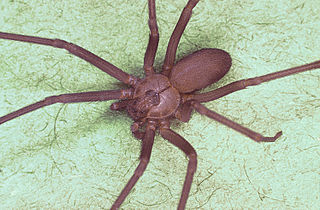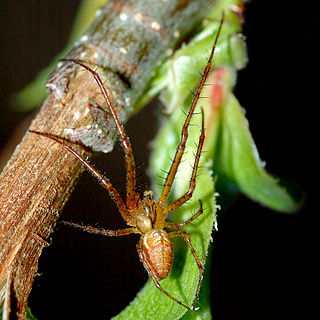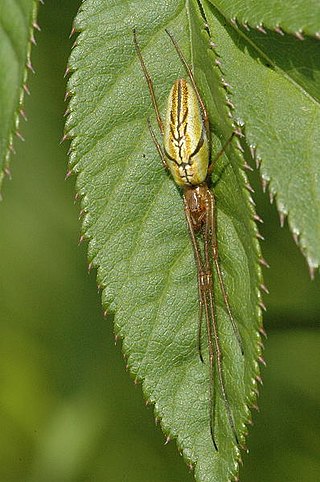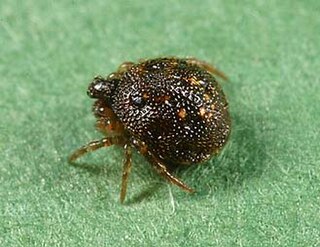
The Thomisidae are a family of spiders, including about 170 genera and over 2,100 species. The common name crab spider is often linked to species in this family, but is also applied loosely to many other families of spiders. Many members of this family are also known as flower spiders or flower crab spiders.

Sicariidae is a family of six-eyed venomous spiders known for their potentially necrotic bites. The family consists of three genera and about 160 species. Well known spiders in this family include the brown recluse spider and the six-eyed sand spider.

Theridiidae, also known as the tangle-web spiders, cobweb spiders and comb-footed spiders, is a large family of araneomorph spiders first described by Carl Jakob Sundevall in 1833. This diverse, globally distributed family includes over 3,000 species in 124 genera, and is the most common arthropod found in human dwellings throughout the world.

Orb-weaver spiders are members of the spider family Araneidae. They are the most common group of builders of spiral wheel-shaped webs often found in gardens, fields, and forests. The English word "orb" can mean "circular", hence the English name of the group. Araneids have eight similar eyes, hairy or spiny legs, and no stridulating organs.

Long-jawed orb weavers or long jawed spiders (Tetragnathidae) are a family of araneomorph spiders first described by Anton Menge in 1866. They have elongated bodies, legs, and chelicerae, and build small orb webs with an open hub with few, wide-set radii and spirals with no signal line or retreat. Some species are often found in long vegetation near water.

Misumenoides is a genus of spiders in the family Thomisidae. Spiders in this family are commonly called "crab" or "flower" spiders.

Cosmophasis is a genus of spiders in the family Salticidae. They are predominantly Southeast Asian, while some species occur in Africa and Australia. Although most species more or less mimic ants, there are also colorful species that follow a different strategy.

The genus name is a combination of the Ancient Greek "argyros" (άργυρος), meaning "silver", and the suffix "-odes", meaning "like".

Hetschkia is a monotypic genus of Brazilian comb-footed spiders containing the single species, Hetschkia gracilis. It was first described by Eugen von Keyserling in 1886, and is found in Brazil.

Wirada is a genus of comb-footed spiders that was first described by Eugen von Keyserling in 1886.

Thwaitesia is a genus of comb-footed spiders that was first described by Octavius Pickard-Cambridge in 1881.

Tetragnatha is a genus of long-jawed orb-weavers found all over the world. It was first described by Pierre André Latreille in 1804, and it contains hundreds of species. Most occur in the tropics and subtropics, and many can run over water. They are commonly called stretch spiders in reference to their elongated body form and their ability to hide on blades of grass or similar elongated substrates by stretching their front legs forward and the others behind them. The name Tetragnatha is derived from Greek, tetra- a numerical prefix referring to four and gnatha meaning jaw. Evolution to cursorial behavior occurred long ago in a few different species, the most studied being those found on the Hawaiian islands. One of the biggest and most common species is T. extensa, which has a holarctic distribution. It can be found near lakes, river banks or swamps. Large numbers of individuals can often be found in reeds, tall grass, and around minor trees and shrubs.

Cryptachaea is a genus of spiders in the Theridiidae family.

Ariamnes is a genus of comb-footed spiders that was first described by Tamerlan Thorell in 1869. Some species have greatly elongated abdomens, making them resemble a twig.
Emertonella is a genus of comb-footed spiders that was first described by E. B. Bryant in 1945.

Phoroncidia is a genus of comb-footed spiders that was first described by J. O. Westwood in 1835.
Audifia is a genus of comb-footed spiders that was first described by Eugen von Keyserling in 1884. As of May 2020 it contains three species, found in Africa and Brazil: A. duodecimpunctata, A. laevithorax, and A. semigranosa.
Helvibis is a genus of spiders in the family Theridiidae that was first described by Eugen von Keyserling in 1884. It is a senior synonym of Formicinoides.
Chthonos is a genus of South American ray spiders that was created by Jonathan A. Coddington in 1986 because the previous name was preoccupied. Originally placed with the Orb-weaver_spiders under the name Tecmessa, it was transferred to the ray spiders in 1986.

Cryptachaea gigantipes, known vernacularly as the white porch spider, is a species of cobweb spider in the family Theridiidae. It is native to south-eastern Australia and is an introduced species in New Zealand.















